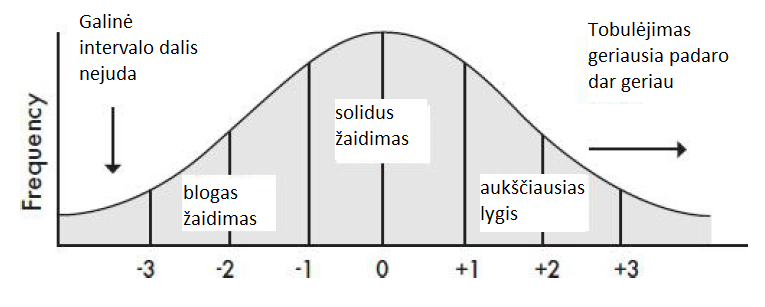Two Main Learning Mistakes
To better understand how the “worm” concept applies in poker, here are two main mistakes players make, along with their solutions:
Ignoring Weaknesses. When players constantly learn new things but at the same time ignore, avoid, and block their weaknesses, their bell curve becomes flatter. Weaknesses are not addressed, so the back (left) part of the curve does not move. At the same time, players have many new skills, so when they play at the highest level, it is higher than ever before. The problem is that by exclusively learning new things, players create a large range in their game. This means that it will take a lot of mental effort to consider all the new concepts.

If your mind is not very sharp, the game experiences a dramatic decline, and bad play becomes even worse.
Here are some more consequences of this approach to learning:
- Playing at the highest level requires a lot of energy, so it doesn't happen very often.
- Mistakes, most of which are elementary, appear out of nowhere.
- It seems that the game has stopped improving and has stabilized.
- You have to think about many things, which often confuses you and makes you miss important details of the hand.
The worst part is that the newly acquired information is still in the learning process, so you won't be able to use it when you tilt, lose concentration, are tired, or nervous while playing a big pot. Every time you experience at least one of those emotions, it feels like someone suddenly pulled the rug out from under you, and you are lying on the ground, losing faith in yourself and wondering what the hell happened. For some players, this leads to doubting every aspect of their game.
Exclusive learning of new things while neglecting your weaknesses can make the difference between a slightly losing player and a solid winner. Preventing this from happening is quite easy – you need to focus on correcting your weaknesses until it becomes unconscious competence. This approach will help you remember your main mistakes and will be the most effective way to improve.
Comparing Your Worst Game to Your Best. The “worm” concept has another important lesson that serves when your game feels tense, tilted, poorly motivated, and lacking concentration. During such periods, it is very difficult to remain optimistic, especially in terms of technical and psychological improvement. However, knowing that you have improved can turn everything upside down, even if it doesn't seem so at the time.
The only way to prove that your bad game (the left part of the curve) has improved is to analyze your bad game and compare it to the game of a previous bad period. So instead of comparing your bad period to your good one (which will show a very big difference and make you feel bad), you must compare equivalent things – bad game to bad game. Remember that only under great tension does your game rely most on unconscious competence skills. And what you see when playing under such circumstances are the biggest weaknesses of your game.
Comparing bad game to previously bad game is a way to prove to yourself that the back part of the curve has moved forward and you have improved. For example, you might still tilt occasionally, but compared to before, now you are more aware, better able to control your emotions, which allows you to play well for a longer period or stop playing when you notice that it's impossible to think clearly. So find out if your bad game has improved at all. A positive answer in the middle of a bad period can give you the much-needed confidence.
This series of articles is based on Jared Tendler's poker psychology book: “Mental Game of Poker”. Those who want to purchase the original, which is in English, can do so on amazon.com





